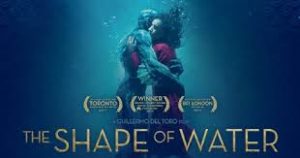Unable to perceive the shape of you,
I find you all around me:
Your presence fills my eyes,
With your love;
You’ve humbled my heart,
For you are everywhere.
-Hakim Sanai
This is the poem shared as an offering to adoration at the end of the much-heralded film The Shape of Water. Directed by Guillermo del Toro, what begins the seemingly impossible love story between a human woman and an amphibian man/deity are the musings of a closeted Gay artist, Giles, played by the effusive Richard Jenkins. He attempts to describe his best friend, the romantic female lead Elisa, rendered with beguiling charm by Sally Hawkins. All are out of their element in many ways and as the otherworldly in- the -midst- of the darkness of Cold War era movie unfolds, they bond in a language spoken and silent. Elisa is mute and bears scars on her neck that may indicate the reason. She communicates via sign language that both Giles and her friend and co-worker Zelda, played by the talented Octavia Spencer (she embodied one aspect of God in The Shack) understand and translate for others when need be.
Elisa and Zelda are employed as janitorial staff at a government facility. Cleaning toilets and scrubbing floors on the overnight shift, they are called into the lab where a being referred to as ‘the asset,’ has been sequestered after being captured by the cartoon character villain named Strickland, played with evil believability by Michael Shannon. A dead giveaway is when he walks into the men’s room as the two women are cleaning, washes his hands before, unzips and urinates in front of them, but doesn’t wash afterward and justifies it.
“A man washes his hands before or after tending to his needs. It tells you a lot about a man. He does it both times – points to a weakness in character.”
His adversarial relationship with the Amphibian Man is one that had me cringing since he seemed to derive pleasure from torturing him with a cattle prod. Doug Jones played the man in the rubber suit resembling The Creature From the Black Lagoon. I heard an interview with him on NPR during which he described the ordeal of suiting up each day and that there was a front flap to the costume, through which he could relieve himself, but not a back flap, so he was unable to eat while taking a break from shooting.
A.M. got his revenge by biting off two of Strickland’s fingers which left a bloody mess for Elisa to clean up as she retrieves the digits and hands them back to him in a paper bag. He has them sewn back on but neglects their care and they end up necrotic which was the perfect symbolism for his rotting heart and soul. Popping pain pills throughout the film does nothing to improve his temperament. Interesting to observe that his family who had “Daddy’s home!” excitement when he walked through the door of their suburban home, had no clue that it was paid for with the brutality toward and blood of another.
In the era of #metoo, this nefarious character evidenced that he liked his women silent; in a disturbing scene with his wife and another with Elisa who gets her own sign language revenge that had me laughing as she spelled out her response to his attempted intimidation.
The love story at the core of the movie begins as curiosity between the two seeming misfits. It is woven with a sensuous ribbon and building trust. Only in her mind and by her own hand, at the onset of the film, Elisa’s sexual pleasure is enlivened when communing with him. Her body is portrayed as if a work of art. Female sexuality is celebrated and the elements of water and eggs are generously sprinkled throughout as symbols of such. The themes of love, overcoming a sense of ‘otherness’, an appreciation of diversity, racism, good vs. evil, miracles, spirituality, healing, determinations, showing up, standing up and speaking out shape the scenes.
It was nominated for 13 Academy Awards and walked away with four: Best Picture, Best Director, Best Original Music Score and Best Production Design.


